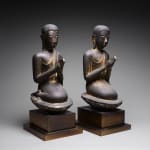Pair of Rattanakosin Gilt Bronze Sculptures of Seated Disciples, 18th Century CE - 19th Century CE
Gilt Bronze
40.6 x 17.8 cm
16 x 7 in
16 x 7 in
X.0252
After the destruction of Ayutthaya in 1767 by the Burmese, King Tak Sin the Great drove out the invaders and reunified the country, establishing a new capital at Thonburi, a...
After the destruction of Ayutthaya in 1767 by the Burmese, King Tak Sin the Great drove out the invaders and reunified the country, establishing a new capital at Thonburi, a strategic river port town at the mouth of the Chao Phraya River. After Tak Sin was deposed, Thong Duang was chosen as king, known as Rama I, establishing the Chakri Dynasty which continues to reign over Thailand to this day. He moved the capital across the banks of the Chao Phraya River to its present location of Bangkok. The art of this period is known as the Rattanakosin style, although it is also referred to as the Bangkok style. Naturally, Rattanakosin art carried on many of the traditions of the Ayutthayan style, thereby establishing a link with the past.
In the Buddhist art of Southeast Asia, two disciples are traditionally displayed flanking important representations of the Buddha. Their presence is historically inaccurate, considering that all of the Buddha’s friends had deserted him at the time of his enlightenment. However, it reflects a traditional (albeit probably historically inaccurate) belief that the religion was introduced into the region by two of his disciples during the Buddha’s lifetime. Here, two disciples are depicted kneeling on individual lotus bases, meditating in quiet contemplation with their hands clutched together. They wear simple robes consistent with the monastic order. Originally, they would have been placed nearby a larger sculpture of the Buddha himself inside an ornately decorated temple. They are always depicted slightly smaller than the Buddha in order to reveal their status as disciples. This lovely bronze pair has been modeled after representations of the Buddha, complete with the same drooping earlobes, creased necks, and spiky hair.
In the Buddhist art of Southeast Asia, two disciples are traditionally displayed flanking important representations of the Buddha. Their presence is historically inaccurate, considering that all of the Buddha’s friends had deserted him at the time of his enlightenment. However, it reflects a traditional (albeit probably historically inaccurate) belief that the religion was introduced into the region by two of his disciples during the Buddha’s lifetime. Here, two disciples are depicted kneeling on individual lotus bases, meditating in quiet contemplation with their hands clutched together. They wear simple robes consistent with the monastic order. Originally, they would have been placed nearby a larger sculpture of the Buddha himself inside an ornately decorated temple. They are always depicted slightly smaller than the Buddha in order to reveal their status as disciples. This lovely bronze pair has been modeled after representations of the Buddha, complete with the same drooping earlobes, creased necks, and spiky hair.



